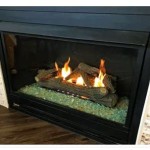How To Refinish Metal Fireplace Doors
Refinishing metal fireplace doors can dramatically improve the aesthetics of a living space, breathing new life into a central feature of the home. Over time, fireplace doors can become dull, scratched, or stained due to heat, soot, and general wear and tear. Instead of replacing them, refinishing offers a cost-effective and relatively straightforward solution. The process involves cleaning, preparing, and applying a heat-resistant finish to restore or change the appearance of the doors. Careful planning and execution are essential for achieving a professional-looking result that enhances the fireplace’s visual appeal and ensures the longevity of the refinished surface.
Before beginning any refinishing project, safety precautions are paramount. Always work in a well-ventilated area, especially when using chemical strippers or spray paints. Wear appropriate personal protective equipment, including gloves, safety glasses, and a respirator mask, to avoid inhaling harmful fumes or getting chemicals on the skin. Protect the surrounding floor and furniture with drop cloths or plastic sheeting to prevent accidental damage from spills or spray paint overspray. Following these safety guidelines minimizes the risk of injury and ensures a safer, more comfortable working environment.
Preparation and Removal
The initial step is detaching the fireplace doors from the fireplace. This usually involves unscrewing or unlatching the doors from their frame. It is important to note the configuration of the hardware and take photographs if necessary to ensure correct reinstallation. Once removed, place the doors on a stable work surface covered with a protective layer. Disassemble the doors as much as possible, removing any glass panels, handles, or decorative elements. This separation allows for thorough cleaning and refinishing of individual components, leading to a more uniform and professional final result.
Cleaning the doors is critical to remove any accumulated soot, grease, and grime. A solution of warm water and mild detergent is usually sufficient for basic cleaning. For stubborn buildup, a specialized fireplace cleaner or degreaser might be necessary. Apply the cleaning solution with a scrub brush or sponge, paying close attention to corners and crevices. Rinse the doors thoroughly with clean water and allow them to dry completely before proceeding to the next stage.
Removing the existing finish is essential for creating a smooth and even surface for the new finish to adhere to. Several methods can be employed for this purpose, including chemical stripping, sanding, or using a wire brush. Chemical stripping involves applying a paint stripper to the doors and allowing it to soften the old finish. Follow the manufacturer’s instructions carefully, as chemical strippers can be corrosive. Once the finish is softened, scrape it away with a plastic scraper. Sanding is another option, using progressively finer grits of sandpaper to smooth the surface. A wire brush can be used to remove loose paint and rust, but it may leave scratches, so it is best suited for heavily corroded or textured surfaces. Choose the method that best suits the type of finish and the condition of the doors.
After removing the old finish, thoroughly clean the doors again to remove any residue from the stripping or sanding process. Wipe them down with a tack cloth to remove any dust particles. Inspect the doors for any imperfections, such as scratches or dents. Fill these imperfections with a metal filler or body putty, following the manufacturer's instructions. Sand the filler smooth once it has dried, ensuring a seamless transition between the filler and the surrounding metal.
Priming and Painting
Applying a primer is crucial for ensuring proper adhesion of the paint and preventing rust formation. Choose a high-temperature primer specifically designed for metal surfaces and capable of withstanding the heat of a fireplace. Apply the primer in thin, even coats, following the manufacturer’s recommendations for drying time. Allow the primer to dry completely before proceeding to the painting stage.
Selecting the right paint is equally important. Use a high-temperature paint specifically formulated for fireplaces or stoves. These paints are designed to withstand the extreme heat without blistering, cracking, or fading. Options include spray paints and brush-on paints, each with its own advantages. Spray paints offer a smooth, even finish and are ideal for intricate designs or hard-to-reach areas. Brush-on paints provide greater control over the application but may require more coats to achieve a consistent finish. Choose a paint in the desired color and finish, taking into consideration the overall aesthetic of the living space.
Apply the paint in thin, even coats, allowing each coat to dry completely before applying the next. This prevents runs, drips, and uneven coverage. If using spray paint, hold the can approximately 10-12 inches from the surface and move it in a consistent, back-and-forth motion. If using a brush-on paint, use a high-quality brush and apply the paint in smooth, even strokes. Avoid applying too much paint in one area, as this can lead to sagging and uneven drying. Multiple thin coats are always preferable to a single thick coat.
Reassembly and Finishing Touches
Once the paint has dried completely, carefully reassemble the fireplace doors, reinstalling any glass panels, handles, or decorative elements that were removed during the disassembly process. Refer to the photographs taken earlier to ensure correct placement of all components. Tighten all screws and fasteners securely, but avoid over-tightening, which could damage the doors or hardware.
Inspect the refinished doors for any imperfections, such as missed spots or areas with uneven coverage. Touch up any areas as needed, using a small brush or a cotton swab. Allow the touch-up paint to dry completely before reinstalling the doors onto the fireplace.
Finally, reinstall the refinished fireplace doors onto the fireplace. Ensure that they are properly aligned and securely fastened. Clean the glass panels with a glass cleaner to remove any fingerprints or smudges. Light a small fire in the fireplace to cure the paint and allow it to fully harden. Follow the paint manufacturer’s instructions for curing time and temperature. With proper care and maintenance, the refinished fireplace doors will enhance the beauty and functionality of the fireplace for years to come.

Fireplace Door Update With Spray Paint Roots Wings Furniture Llc

Painted Fireplace Doors 6 Steps With S Instructables

Fireplace Door Update With Spray Paint Roots Wings Furniture Llc

How To Spray Paint A Brass Fireplace Insert Erfly House

How To Spray Paint A Brass Fireplace Insert Erfly House

How To Spray Paint A Brass Fireplace Bright Green Door

Brass Painting S Instructions A Fireplace Black

Repainting Brass Fireplace Doors Spraypaint And Deglosser Remodel Frame

How To Refinish Rusted Fireplace Doors

Fireplace Door Update With Spray Paint Roots Wings Furniture Llc
Related Posts








